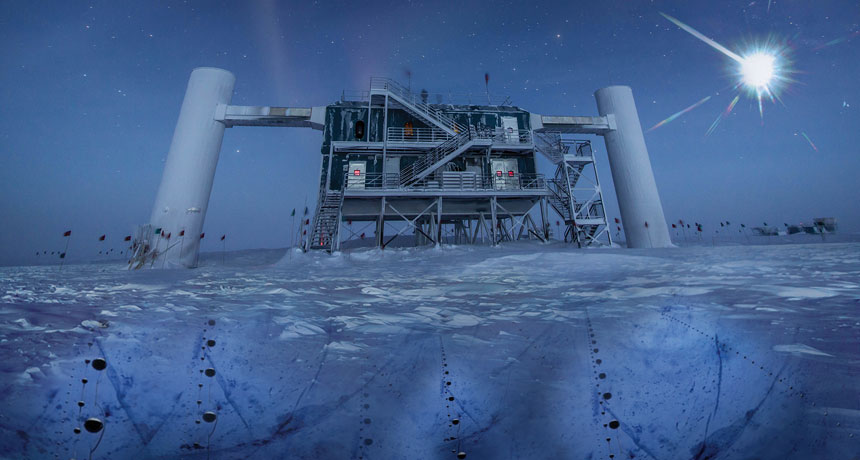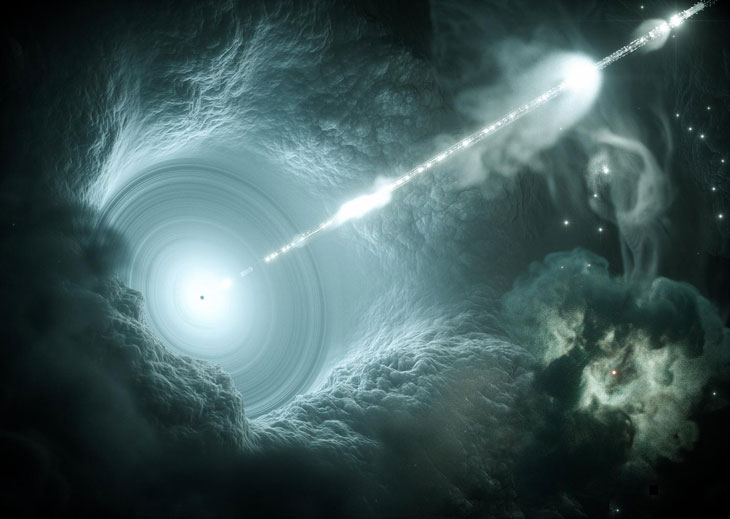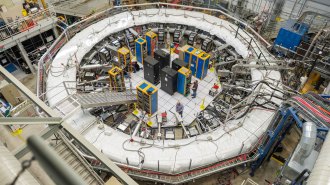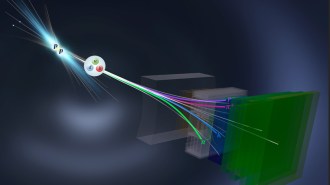Neutrino discovery launched a new type of astronomy
Scientists trace a mysterious high-energy particle to its distant home

DEEP DOWN At the IceCube detector at the South Pole, sensors buried below the ice detect neutrinos from a distant source, perhaps a blazar, in this artist’s composition.
IceCube/NSF
- More than 2 years ago
Mysterious particles called neutrinos constantly barrel down on Earth from space. No one has known where, exactly, the highest-energy neutrinos come from. This year, scientists finally put a finger on one likely source: a brilliant cosmic beacon called a blazar. The discovery could kick-start a new field of astronomy that combines information gleaned from neutrinos and light.
It began with one high-energy neutrino spotted on September 22, 2017, by the IceCube observatory, a giant particle detector with thousands of sensors buried deep in the ice at the South Pole. Alerted by IceCube, astronomers soon spotted a flare from a blazar about 4 billion light-years away. The neutrino had come from the same area of the sky. With that matchup in time and space between the neutrino and the blazar’s light, scientists in 2018 pegged the blazar as the particle’s probable source (SN: 8/4/18, p. 6).
“People have been hoping for this kind of discovery for decades,” says astrophysicist Meg Urry of Yale University.
Blazars are active regions at the centers of galaxies that spew jets of high-energy matter and light toward Earth. Both the Earth-orbiting Fermi Gamma-ray Space Telescope and the Major Atmospheric Gamma Imaging Cherenkov, or MAGIC, telescopes in the Canary Islands reported that the blazar was violently flaring up in gamma rays, a type of high-energy light, at about the same time the neutrino was detected.
After combing through old data, IceCube researchers found evidence of even more neutrinos from near the blazar’s location in the sky. With those extra neutrinos, the researchers were finally convinced that the blazar birthed neutrinos.

Not only did the detection hint at the source of at least some high-energy spacefaring particles, it also taught physicists a few things about blazars. Scientists weren’t sure what kinds of particles blazars emit, but the detection reveals that the jets contain protons. That’s because scientists know that any neutrino from a blazar would have to be produced in combination with protons.
The discovery, scientists say, could invigorate a nascent field, dubbed multimessenger neutrino astronomy, to reveal secrets of the cosmos, whether from blazars or other sources. Now, says astrophysicist Kohta Murase of Penn State, “we can use neutrinos as very important probes” to learn more about the objects that spit them out. For example, researchers might spot neutrinos from a collision of two neutron stars, like the one detected by the Advanced Laser Interferometer Gravitational-Wave Observatory, LIGO, in 2017 (SN: 11/11/17, p. 6). IceCube didn’t see any neutrinos from that event, but astrophysicists are hopeful that future neutron star smashups will produce a neutrino bounty.
Before scientists are fully confident that blazars can blast out high-energy neutrinos, researchers need to spot more of the wily particles, Murase says. To improve detection, an upgrade to IceCube will make the detector 10 times bigger in volume and should be ready by the mid-2020s, says Francis Halzen, leader of IceCube and an astrophysicist at the University of Wisconsin–Madison. If all goes well, the tiny particles may soon be revealing secrets from new corners of the cosmos.








